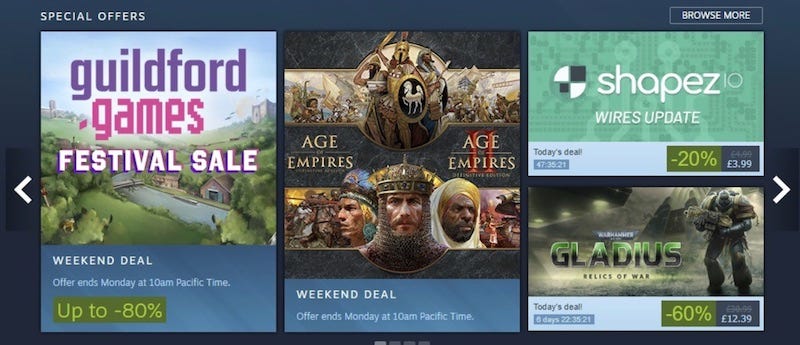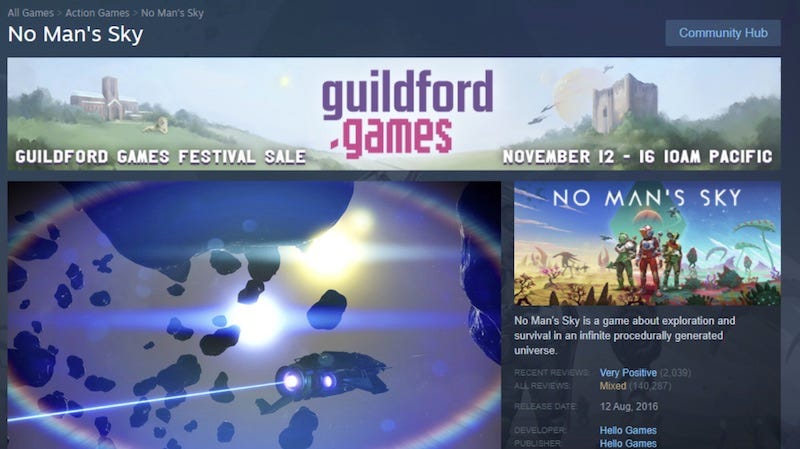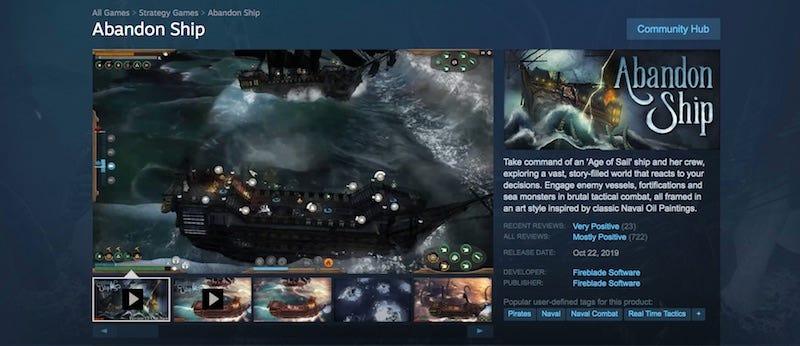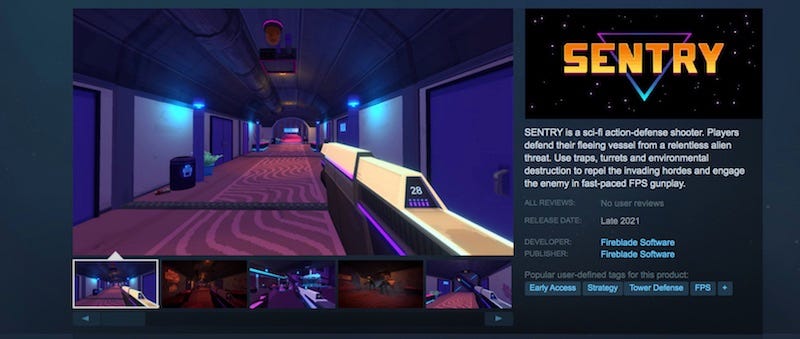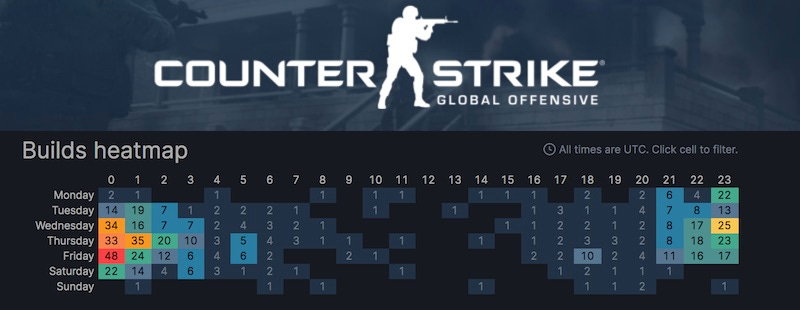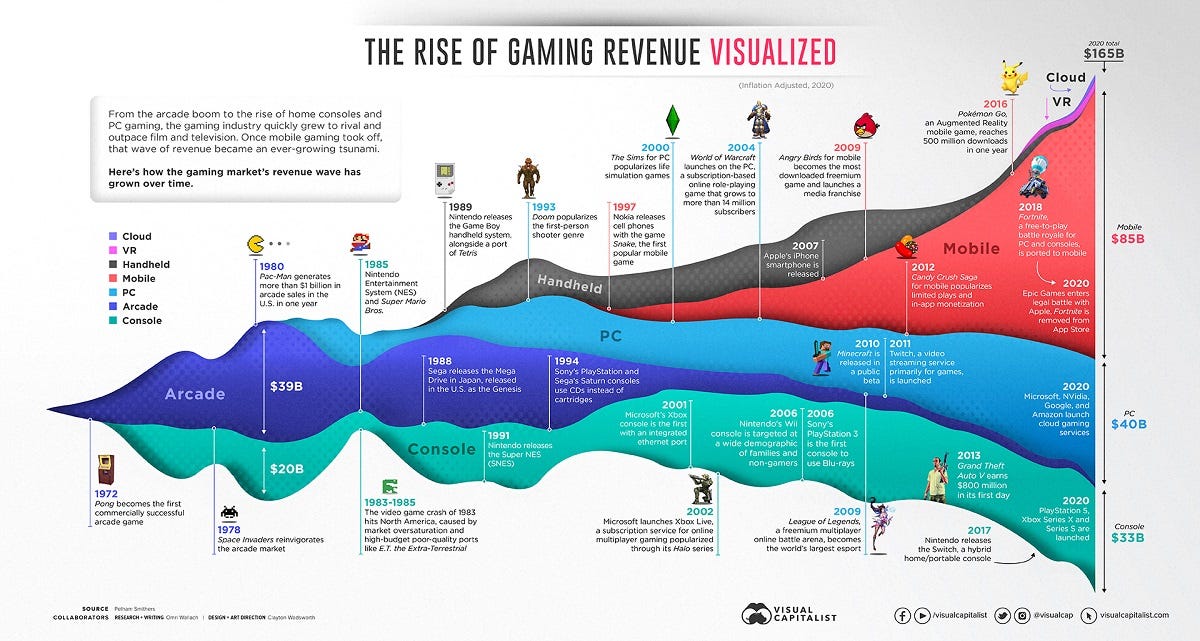The anatomy of a Steam sale
Publikováno: 25.11.2020
What happens when you get featured? We've got stats.
[The GameDiscoverCo game discovery newsletter is written by ‘how people find your game’ expert & GameDiscoverCo founder Simon Carless, and is a regular look at how people discover and buy video games in the 2020s.]
Welcome to the newest GameDiscoverCo newsletter! For this installment, our main section is a guest post from Gary Burchell of Fireblade Software (Abandon Ship), a veteran UK-based game dev who’s just organized the Guildford Games Festival sale on Steam.
Gary was kind enough to write up his Steam sales experiences for us, which I think many of you may find interesting! Take it away, Gary:
The anatomy of a Steam sale
The themed Guildford Games sale on Steam ran from Thursday, 12th November 2020 at 10am PT to Monday, 16th November 10am PT. It coincided with the main [virtual, due to COVID] Guildford Games Festival which ran on the 13th and 14th November, and was organized by Sam Read and others.
[NOTE FROM SIMON: Guildford is a town located south of London in England which is a hotbed of video game dev, largely because Peter Molyneux’s original Theme Park/Dungeon Keeper dev Bullfrog was based there. Actually, I used to work locally in the late ‘90s at Kuju Entertainment. Famous studios there include Criterion/EA, Hello Games, & more.]
I wanted the page to have multiple objectives:
Help lift the Guildford games cluster into a global spotlight
Have a tangible impact on local developers (particularly indies) by providing visibility resulting in wishlists and sales
Provide an income boost with the participation of [Fireblade’s pirate tactics game]Abandon Ship
Help drive some wishlists to an early store page for [Fireblade’s upcoming action defense FPS]SENTRY
I initially got approval from Valve to gain access to the sales page tools. After setting the page up and populating it, Valve had already said they may be able to grant the sale a “Daily Deal” slot.
A couple of weeks before the Festival, I wanted to show Valve that we were taking this extremely seriously, and also hoped we could get even more visibility. By now the page had some cool artwork and there were lots of games on it, most of which were discounted. It had the desired effect - we were treated to an increased ‘weekend deal’ slot along with a pop-up message when you log into Steam.
Forty one of the forty nine released games on the Guildford Games Festival sales page had discounts ranging from 10% to 80%. Each section was split into categories grouped by user review numbers that had varying capsule sizes.
Festival marketing statistics…
There are no obvious places to derive marketing stats (Valve confirmed they are working on tools for this in the future.) But there is evidence of sales page visits from the following information:
The events dashboard shows a “Reads” value of 1,740,086
An Abandon Ship sales page impressions stat of 1,958,394 (Abandon Ship was approximately a third of the way down the page)
A SENTRY sales page impressions stat of 1,313,632 (SENTRY was pretty much at the bottom of the page)
Dan Thomas from Etchplay (who was responsible for streaming the festival content) looked at the broadcast stats page and saw 2.7M unique views – although this was across two sessions, so there could be some minor duplication in the stats.
I therefore estimate that the page received between 1.75M and 2.5M visitors. There is no data for impressions available. There is no way the festival could have achieved these numbers without Steam featuring.
From reviewing the Global Top Sellers charts at various points over the festival duration, at one point there were seventeen participating games in the top 500 sellers on Steam. There were sixteen in the top 400. The highest positions were reached by Need For Speed Heat (6th overall at one point) and No Man’s Sky (10th overall).
Fireblade’s marketing stats…
A “Sales Page” option was displayed in the marketing section of the Steam back end. This accounted for nearly 2 million impressions, 27,482 store page visits at a click-thru rate of 1.4% (low compared to our lifetime stats).
Because our broadcast surfaced to the front page and generated approximately 1.1M impressions (and a typically low click-thru rate), it skewed our overall data for the duration of the festival:
The most popular day was Friday, followed by Saturday, Sunday, Thursday and Monday. As with any general increase in Steam popularity, a temporary boost to Discovery Queue occurs. Elsewhere, SENTRY was in the lowest section of the page and received 1.3M impressions, with a 0.33% click-thru rate resulting in 4.3k store page visits.
Festival sales/wishlists for Fireblade
Our sales for Abandon Ship during the 5-day festival period increased by 48 times compared to an “average” week (i.e. no featuring, discounts or external marketing). The top 5 countries were USA, China, Germany, Russia and UK which is consistent with our normal popularity by country.
Versus the Pirate-themed sale, we sold 17% less copies. However, this puts us in a similar ballpark, and performed above my original expectations.
We've had a lot of recent discounts, so were expecting wishlist conversion rates to be lower than normal. This was indeed the case, 40% of the copies sold came from Wishlist purchases (usually 50%+.) As with previous featuring, net wishlists increased (in this instance by over 2,000).
Analysis of SENTRY’s ‘stealth launch’..
We wouldn’t ordinarily release a Steam page for a new game until we had a suitably impressive announcement trailer to go with it. However, the recent Daily Deal along with the Festival featuring provided an opportunity for high visibility that we felt should not be missed.
We therefore released a Steam page for SENTRY, and made it looks as professional as we could with minimal assets. We received over 1,500 wishlists during this period. Considering how barebones the page looks, this feels like a strong result, especially as I estimate that wishlists have decreased in value, and you need 3-4 times the amount we did when Abandon Ship released in early 2018 to achieve similar launch results.
This would mean that 35% of the store page visits converted to Wishlists. I don’t believe this is accurate, and suspect that many people pressed the “add to wishlist” button that appears on the capsule image from the main Festival sale page.
[Concluding, there’s a lot more useful context/info - including sale layout info and more stats - in Gary’s full document, which we’ve hosted over on GameDiscoverCo’s website. Thanks again to him for making it available to all of us!]
The game discovery news round-up..
After that mammoth - and helpful - update, let’s get on with the other game discovery and platform news, to round out this final regular newsletter of the week. (Reminder: GameDiscoverCo Plus subscribers get an extra exclusive newsletter on Friday, using our custom Steam Hype chart to look at next week’s biggest game releases in detail!)
Lots of good stuff to cover this time, so let’s go for it:
SteamDB.info has added a heatmap for Steam game patch frequency and timing by day (see above pic), which is pretty darn fun. Pavel from SteamDB also notes: “You can click any cell to filter now. Click Sunday to view all builds on that day, or click a specific cell to see builds on that day and hour.” It’s entertaining - and instructional - to see which games update on which days.
The successes in games often get written up to death. The hard slogs to a disappointing finish line? Less so. An exception: this Patrick Klepek piece for Vice about the recent release of Ray’s The Dead, which is super honest about the multi-year dev challenges of an average studio: “The Pikmin-inspired project was imagined as an early indie stand out for the new PlayStation 4. It would then spend years in development hell, arriving a few weeks before the PlayStation 5.”
Steam’s Top 20 new games (by revenue) for October 2020 have been released, and I love it that once again, over 50% of them are from dev studios bringing a game to Steam for the first time. (And the geographical diversity is high as well. Interesting that one of the Top 5 F2P games for the month - Soulworker from South Korea - isn’t even available on the U.S. version of Steam yet.)
This transcript of a Phil Spencer interview on Xbox’s strategy (and Game Pass) at The Verge has a LOT of good, pointed questions. Too many to highlight now, but on ‘why shouldn’t iOS have blockers/fees, but Xbox can?’: “Those are general compute platforms. A game console does one thing really; it plays video games. It’s sold, for us, at a loss. Then you make money back by selling content and services on top. The model is just very, very different from something [on] the scale of Windows, or iOS, or Android.”
The excellent Ryan Sumo (who was so transparent with us on Academic: School Simulator sales on Steam) made a new post on how to integrate player feedback into your Early Access game: “The dirty secret of player feedback is that it’s not easy to parse what is good, actionable feedback versus the impossible task of trying to cater to the whims of every single player. There’s also the real risk that you lose the soul of your game by simply agreeing to all the suggestions sent your way.”
Enjoyed the latest SuperJoost Playlist newsletter on UGC (user-generated content) - lots of meaty commentary in there, on Roblox and other platforms: “Creative firms will increasingly rely on their users to provide the content that keeps their games popular. The sheer volume means that user-generated content will soon be commonplace and central to the way we think about online and digital experiences.”
Victoria Tran (now leading community for Among Us!) posted a list of her favorite talks/material on game marketing and communities. Lots of great material from GDC Indie Summit in here (hurray!), and I love seeing wider cultural material (Bo Burnham, ‘So You’ve Been Publicly Shamed’) in a list of recommendations, too.
Microlinks: Google Stadia keeps expanding catalog with new Stadia Pro ‘free’ games (Into The Breach, Hitman 2, Kine, more…); Paolo Pedercini’s talk transcript on Flash’s demise has interesting things to say about digital platform decay in general; the latest #PitchYaGame Twitter hashtag showcase of ‘neat indie games’ just happened - go peep the results.
Finally this week, after the Super Famicom sales chart in the last newsletter, here’s a chart on a whole different scale. Let’s look at estimated revenue for all 50 years of the video game industry (!), via this VisualCapitalist post and estimates from Pelham Smithers:
[This newsletter is handcrafted by GameDiscoverCo, a new agency based around one simple issue: how do players find, buy and enjoy your premium PC or console game. You can now subscribe to GameDiscoverCo Plus to get access to exclusive newsletters, interactive daily rankings of every unreleased Steam game, and lots more besides!]
